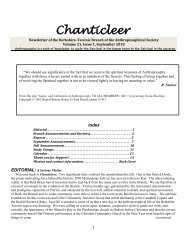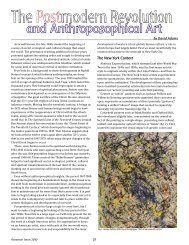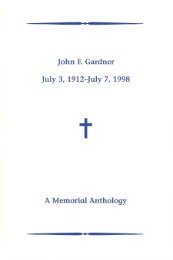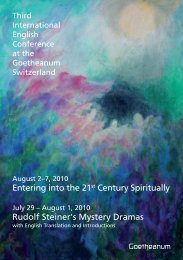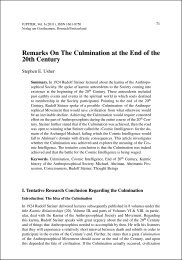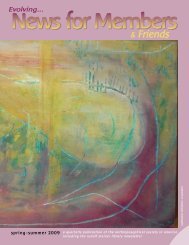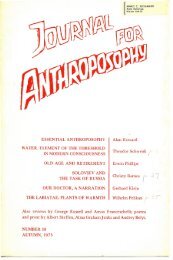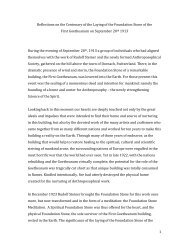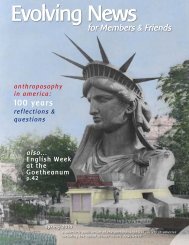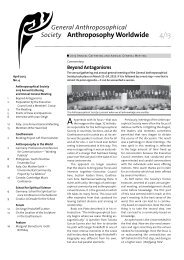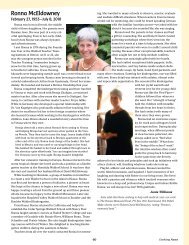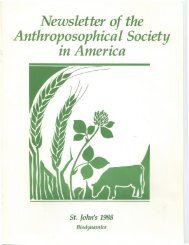& Friends - Anthroposophical Society in America
& Friends - Anthroposophical Society in America
& Friends - Anthroposophical Society in America
You also want an ePaper? Increase the reach of your titles
YUMPU automatically turns print PDFs into web optimized ePapers that Google loves.
The Web as Will and IdeaEugene SchwartzIn the summer of 1984 I was <strong>in</strong>vited to the Goetheanum bythe Section for Belles-Lettres 1 to help lead an English-languageconference on the <strong>in</strong>fluence of Albert Steffen <strong>in</strong> the West.Throughout the conference week the leaders would gather <strong>in</strong>the even<strong>in</strong>g <strong>in</strong> the office of Hagen Biesantz, the Section leader.One night, after a long and lively conversation, we made readyto leave, only to discover that we were locked <strong>in</strong>side the build<strong>in</strong>g.Even <strong>in</strong> those pre-9/11 days the Goetheanum had a vigilantsecurity team who, though they saw us walk<strong>in</strong>g through thehallways, had no <strong>in</strong>tention of releas<strong>in</strong>g us. The sight and soundof those men <strong>in</strong> brown uniforms call<strong>in</strong>g out commands to theirpolice dogs <strong>in</strong> harsh Swiss-German, evoked some unpleasant associations<strong>in</strong> the m<strong>in</strong>d of this Jewish boyfrom Brooklyn. I was relieved when Dr.Biesantz said that he knew of anotherway out of the build<strong>in</strong>g.Down, down, down we went <strong>in</strong>to passagesso constricted and labyr<strong>in</strong>th<strong>in</strong>ethat they seemed to confirm the Goetheanum’sstature as a modern mysterycenter. The exit was <strong>in</strong> sight, but beforewe came to it Dr. Biesantz drew us tothe nondescript door of a storage room.“Come <strong>in</strong>,” he said, unlock<strong>in</strong>g the portaland switch<strong>in</strong>g on the light, “Look!”There it rested, immutable, bland,and mostly plastic: the Goetheanum’sfirst (and only) computer. “We don’tknow what to do with it,” Dr. Biesantzconfided to our pale and shaken group(first the police dogs, and now . . . . this.And it was 1984!). He went on. “It is theunmentionable,” he <strong>in</strong>toned, and placedhis foref<strong>in</strong>ger aga<strong>in</strong>st his lips. We understoodthat we were pledged to silence.Today, of course, the idea of a solitary computer is all butunth<strong>in</strong>kable. In the Goetheanum, as <strong>in</strong> many centers of anthroposophyworldwide, computers work <strong>in</strong> tandem, whetherthrough <strong>in</strong>ternal networks or the <strong>in</strong>ternet. In spite of the remarkableproliferation of computers throughout the anthroposophicalmovement (compared, say, to devices such as televisions oriPods) very little has been written about them. We must thereforebe especially grateful to Sergei Prokofieff for “The Be<strong>in</strong>g ofthe Internet,” an article that appeared <strong>in</strong> the English-languagePacifica Journal three years ago. 2 The article is no less germanenow than it was <strong>in</strong> 2006, and with the hope of mak<strong>in</strong>g it knownto a wider audience I offer the follow<strong>in</strong>g elucidation.As is only to be expected, Prokofieff’s article is concise and1 This section is now known <strong>in</strong> the USA as the Section for the LiteraryArts & Humanities.2 Editor’s note: Pacifica Journal noted prior publication <strong>in</strong> the newsletterof the <strong>Anthroposophical</strong> <strong>Society</strong> <strong>in</strong> Great Brita<strong>in</strong>. The first USE-News po<strong>in</strong>ted the article out onl<strong>in</strong>e last spr<strong>in</strong>g, and the San MiguelBranch newsletter <strong>in</strong> San Diego repr<strong>in</strong>ted the article this fall.well researched. He touches on so many important po<strong>in</strong>ts <strong>in</strong>such a compressed way that it would be far beyond the scope ofthis article to speak to them all. Therefore, <strong>in</strong> this commentary Iwant to address only three of the myriad issues he raises:1. Who stands beh<strong>in</strong>d the <strong>in</strong>ternet?2. The question of the compression of spiritual content.3. Our responsibility vis-à-vis the <strong>in</strong>ternet.The Imag<strong>in</strong>ation of the Spiderweb“It is frighten<strong>in</strong>g,” Prokofieff writes, “how poignantly RudolfSte<strong>in</strong>er describes this spirit world <strong>in</strong> comparison with the worldsituation of today,” and he then presents a lengthy quote fromPerspectives on Human Development, aMay 13, 1921 lecture. Because this lectureis not readily available, I, too, willquote his excerpt <strong>in</strong> full:And from the earth will well up terriblecreations of be<strong>in</strong>gs who <strong>in</strong> their characterstand between the m<strong>in</strong>eral k<strong>in</strong>gdom andthe plant k<strong>in</strong>gdom as automative be<strong>in</strong>gswith a super-natural <strong>in</strong>tellect, an immense<strong>in</strong>tellect. When this development takeshold, the earth will be covered, as witha web, a web of terrible spiders, spidersof enormous wisdom, which, however,<strong>in</strong> their organization doesn’t even reachthe plant status. Terrible spiders whichwill <strong>in</strong>terlock with each other, whichwill imitate <strong>in</strong> their movements all thatwhich humanity has thought of with theirshadowlike <strong>in</strong>tellect that was not <strong>in</strong>spiredby a new imag<strong>in</strong>ation, through that whichis to come through Spiritual Science. Allman’s thoughts of this k<strong>in</strong>d, which areunreal, will come alive. The earth will becovered […] with terrible m<strong>in</strong>eral-plantlike spiders, which will l<strong>in</strong>k up with empathy but evil <strong>in</strong>tention.And man […] will have to unite with these terrible m<strong>in</strong>eralplantlike spider creatures.Prokofieff goes on to say,These spider creatures will be of a dist<strong>in</strong>ctly ahrimanic character.When you read these prophetic words of the spiritual scientisttoday, <strong>in</strong> an era of world wide connections via computerand the <strong>in</strong>ternet you may be disheartened to f<strong>in</strong>d how quicklythis prophecy has become a reality on earth. It is as if RudolfSte<strong>in</strong>er, with his spiritual gaze, described today’s <strong>in</strong>ternet frombeyond the threshold, categorically warn<strong>in</strong>g humanity that <strong>in</strong>a not too distant future, with the unification of the moon andearth, this whole <strong>in</strong>ternet-computer-web and <strong>in</strong> fact everyth<strong>in</strong>gconnected with the development of artificial <strong>in</strong>tellect will suddenlycome alive . . . .Ste<strong>in</strong>er’s 1921 lecture is unusual for its strongly prophetictone. As if the nearly apocalyptic picture of the spider webs andtheir sp<strong>in</strong>ners were not enough, Ste<strong>in</strong>er also spoke of “Supermen,”super-human be<strong>in</strong>gs who began to descend to the earthFall-W<strong>in</strong>ter 200915



